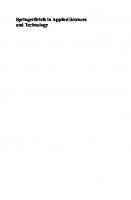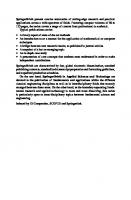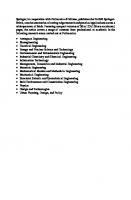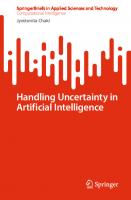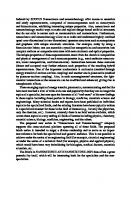Special Topics in Information Technology (SpringerBriefs in Applied Sciences and Technology) 3031153731, 9783031153730
This open access book presents outstanding doctoral dissertations in Information Technology from the Department of Elect
163 102 5MB
English Pages 160 [150] Year 2022
Preface
Contents
System and Control
Data-Informed Models for the Coupled Dispersal of Microplastics and Related Pollutants Applied to the Mediterranean Sea
1 Introduction
2 Methods
3 Coupling the Lagrangian and the Eulerian Frameworks
4 Data Sources and Processing
4.1 Oceanographic Data
4.2 Drivers of Plastic-Related Pollution in the Mediterranean Sea
4.3 Plastic Pollution Originating from Coastal Population
4.4 Plastic Pollution Originating in River Watersheds
4.5 Plastic Pollution from Fishing Activities
5 Results
6 Conclusions and Perspectives
References
Enhancing the Quality of Human-Robot Cooperation Through the Optimization of Human Well-Being and Productivity
1 Introduction
2 Understanding the Impact of the Robot Interaction Role on the Human Physiological Stress and Productivity
3 Real-Time GT-Based Method to Maximize the Human Performance and Mitigate the Cognitive Stress in HRC
3.1 Results
4 A Dynamic Task Allocation Strategy to Mitigate the Human Physical Fatigue During HRC
4.1 Results
5 Conclusions
References
Dynamic Sediment Connectivity Modelling for Strategic River Basin Planning
1 Introduction
2 Model Structure
2.1 Initialization
2.2 Main D-CASCADE Loop
3 Case Studies
3.1 Bega River System
3.2 3S River System
4 Conclusion
References
Electronic
Gamma-Ray Spectroscopy and Imaging with SiPMs Readout of Scintillators: Front-End Electronics and Position Sensitivity Algorithms
1 Introduction
2 GAMMA: A Novel Indirect Conversion Detector
3 Architecture of GAMMA Module
4 GAMMA ASIC
4.1 GAMMA ASIC Top Level Architecture
4.2 Adaptive Gain Control circuit
4.3 Current Buffer Input Stage
5 Spectroscopy and Position Sensitivity Experimental Measurements
6 Conclusion
References
Ultra-High Performance Digital Electronic Architectures for Events Management in Real Time Environments
1 Introduction
2 New TDC at the State-Of-Art in FPGA
3 High-Performance Data-Serialization
4 Multi-TDCs Synchronization Techniques
5 Felix Instrument
6 Conclusions and Future Developments
References
Computer Science and Engineering
Temporal Logic and Model Checking for Operator Precedence Languages: Theory and Applications
1 Introduction
1.1 Automated Verification
1.2 Model-Checking Computer Programs
2 Background on Operator Precedence Languages
3 OP-Words and POTL
3.1 Operator-Precedence Words
3.2 Precedence-Oriented Temporal Logic
3.3 Theoretical Results
4 Verifying Programs with Exceptions
5 Conclusions and Future Work
References
Deep and Wide Tiny Machine Learning
1 Introduction
2 Related Literature
3 Deep Tiny Machine Learning
4 On-Device Tiny Machine Learning
5 Wide (Deep) Tiny Machine Learning
6 Conclusions
References
Learning in the Presence of Multiple Agents
1 Introduction
2 Preliminaries
2.1 (Multi-agent) Reinforcement Learning
2.2 Inverse Reinforcement Learning
3 Inverse Reinforcement Learning in Multi-agent Environments
3.1 Multiple-intentions Inverse Reinforcement Learning
3.2 Inverse Reinforcement Learning from a Learning Agent
4 Online Learning in Multi-agent Reinforcement Learning
4.1 Online Learning in Non-cooperative Configurable Markov Decision Processes
4.2 Online Learning in General-Sum Stochastic Games
5 Conclusions
References
Post-cloud Computing: Addressing Resource Management in the Resource Continuum
1 The Resource Continuum
1.1 A Comprehensive Architecture
2 The BarMan Framework
2.1 The BarbequeRTRM Resource Manager
2.2 libmango: A Task-Based Programming Model
2.3 Transparent Tasks Distribution: BeeR
2.4 Use-Case Evaluation Scenarios
3 Exploiting Mobile Devices
3.1 Run-Time Adaptive Application Execution
4 Conclusions and Future Directions
References
Telecommunications
Intelligent Networked Music Performance Experiences
1 Introduction
2 The neTworkEd Music PErfoRmANCe rEsearch (TEMPERANCE) Framework
2.1 Study I: Latency Perception in NMP
2.2 Study II: Audiovisual Immersion in NMP
3 The Intelligent Networked Music PERforMANce experiENCEs (IMPERMANENCE) Framework
4 Latency Compensation Through Adaptive Metronomes
5 Spatial Audio Reproduction
5.1 Source Localization Using Distributed Microphones Based on Ray Space Transform and Deep Learning
5.2 Source Localization Through Frequency-Sliding Generalized Cross-Correlation
5.3 Soundfield Synthesis Through Irregular Loudspeaker Arrays
6 Speech Reconstruction from CNN Embeddings
7 Conclusion
References
Fast and Robust Estimation of Atmospheric Phase Screens Using C-Band Spaceborne SAR and GNSS Calibration
1 Introduction
2 The Essence of SAR and InSAR
3 Tropospheric Effects on SAR Data
4 Atmospheric Phase Screen Estimation
4.1 Data Pre-processing
4.2 Phase Linking for APS Estimation
4.3 GNSS Calibration
4.4 Transforming the Maps from Differential to Absolute
5 Results with Sentinel-1 Data
6 Conclusion
References
How Deep Learning Can Help Solving Geophysical Inverse Problems
1 Introduction
2 RTM Image Enhancement Through GANs
2.1 Generative Adversarial Networks
2.2 Experimental Results
3 Seismic Data Interpolation Through Deep Priors
3.1 Experimental Results
3.2 Tackle Aliasing with Event Dips
4 CNN Landmine Detection
4.1 Experimental Results
5 Conclusions
References
Recommend Papers

- Author / Uploaded
- Carlo G. Riva (editor)
File loading please wait...
Citation preview
SpringerBriefs in Applied Sciences and Technology PoliMI SpringerBriefs Carlo G. Riva Editor
Special Topics in Information Technology
SpringerBriefs in Applied Sciences and Technology
PoliMI SpringerBriefs Series Editors Barbara Pernici, Politecnico di Milano, Milano, Italy Stefano Della Torre, Politecnico di Milano, Milano, Italy Bianca M. Colosimo, Politecnico di Milano, Milano, Italy Tiziano Faravelli, Politecnico di Milano, Milano, Italy Roberto Paolucci, Politecnico di Milano, Milano, Italy Silvia Piardi, Politecnico di Milano, Milano, Italy
Springer, in cooperation with Politecnico di Milano, publishes the PoliMI SpringerBriefs, concise summaries of cutting-edge research and practical applications across a wide spectrum of fields. Featuring compact volumes of 50 to 125 (150 as a maximum) pages, the series covers a range of contents from professional to academic in the following research areas carried out at Politecnico: • • • • • • • • • • • • • • • •
Aerospace Engineering Bioengineering Electrical Engineering Energy and Nuclear Science and Technology Environmental and Infrastructure Engineering Industrial Chemistry and Chemical Engineering Information Technology Management, Economics and Industrial Engineering Materials Engineering Mathematical Models and Methods in Engineering Mechanical Engineering Structural Seismic and Geotechnical Engineering Built Environment and Construction Engineering Physics Design and Technologies Urban Planning, Design, and Policy
Carlo G. Riva Editor
Special Topics in Information Technology
Editor Carlo G. Riva Dipartimento di Elettronica, Informazione e Bioingegneria Politecnico di Milano Milano, Italy
ISSN 2191-530X ISSN 2191-5318 (electronic) SpringerBriefs in Applied Sciences and Technology ISSN 2282-2577 ISSN 2282-2585 (electronic) PoliMI SpringerBriefs ISBN 978-3-031-15373-0 ISBN 978-3-031-15374-7 (eBook) https://doi.org/10.1007/978-3-031-15374-7 © The Editor(s) (if applicable) and The Author(s) 2023. This book is an open access publication. Open Access This book is licensed under the terms of the Creative Commons Attribution 4.0 International License (http://creativecommons.org/licenses/by/4.0/), which permits use, sharing, adaptation, distribution and reproduction in any medium or format, as long as you give appropriate credit to the original author(s) and the source, provide a link to the Creative Commons license and indicate if changes were made. The images or other third party material in this book are included in the book’s Creative Commons license, unless indicated otherwise in a credit line to the material. If material is not included in the book’s Creative Commons license and your intended use is not permitted by statutory regulation or exceeds the permitted use, you will need to obtain permission directly from the copyright holder. The use of general descriptive names, registered names, trademarks, service marks, etc. in this publication does not imply, even in the absence of a specific statement, that such names are exempt from the relevant protective laws and regulations and therefore free for general use. The publisher, the authors, and the editors are safe to assume that the advice and information in this book are believed to be true and accurate at the date of publication. Neither the publisher nor the authors or the editors give a warranty, expressed or implied, with respect to the material contained herein or for any errors or omissions that may have been made. The publisher remains neutral with regard to jurisdictional claims in published maps and institutional affiliations. This Springer imprint is published by the registered company Springer Nature Switzerland AG The registered company address is: Gewerbestrasse 11, 6330 Cham, Switzerland
Preface
This volume is a collection of the most promising results achieved by graduated Ph.D.s in Information Technology (IT) at the Department of Electronics, Information and Bioengineering of the Politecnico di Milano. The presented contributions summarize the main achievements of their theses, successfully defended in the a.y. 2021–2022 and selected for the IT Ph.D. Award (out of more than 50 theses defended this year). As in the tradition of this Ph.D., program, these theses cover a wide range of topics in IT, reflecting the broad articulation of the program in the areas of computer science and engineering, electronics, systems and control, and telecommunications, and emphasizing the interdisciplinary nature of IT. Doctoral studies in the IT Ph.D. program pursue state-of-the-art research and the development of innovative, cuttingedge methodologies and technologies, and aim at preparing generations of young researchers that will shape future innovation, as the 12 authors of this volume will undoubtedly do. Overall, this book gives an overview of some of the newest research trends in IT developed at the Politecnico di Milano, presenting them in an easy-to-read format, amenable also to non-specialists. Milan, Italy July 2022
Carlo G. Riva
v
Contents
System and Control Data-Informed Models for the Coupled Dispersal of Microplastics and Related Pollutants Applied to the Mediterranean Sea . . . . . . . . . . . . . Federica Guerrini
3
Enhancing the Quality of Human-Robot Cooperation Through the Optimization of Human Well-Being and Productivity . . . . . . . . . . . . . . Costanza Messeri
15
Dynamic Sediment Connectivity Modelling for Strategic River Basin Planning . . . . . . . . . . . . . . . . . . . . . . . . . . . . . . . . . . . . . . . . . . . . . . . . . . . . Marco Tangi
27
Electronic Gamma-Ray Spectroscopy and Imaging with SiPMs Readout of Scintillators: Front-End Electronics and Position Sensitivity Algorithms . . . . . . . . . . . . . . . . . . . . . . . . . . . . . . . . . . . . . . . . . . . . . . . . . . . . . . . . Luca Buonanno Ultra-High Performance Digital Electronic Architectures for Events Management in Real Time Environments . . . . . . . . . . . . . . . . . . Fabio Garzetti
41
53
Computer Science and Engineering Temporal Logic and Model Checking for Operator Precedence Languages: Theory and Applications . . . . . . . . . . . . . . . . . . . . . . . . . . . . . . . . Michele Chiari Deep and Wide Tiny Machine Learning . . . . . . . . . . . . . . . . . . . . . . . . . . . . . Simone Disabato
67 79
vii
viii
Contents
Learning in the Presence of Multiple Agents . . . . . . . . . . . . . . . . . . . . . . . . . Giorgia Ramponi
93
Post-cloud Computing: Addressing Resource Management in the Resource Continuum . . . . . . . . . . . . . . . . . . . . . . . . . . . . . . . . . . . . . . . . . 105 Michele Zanella Telecommunications Intelligent Networked Music Performance Experiences . . . . . . . . . . . . . . . 119 Luca Comanducci Fast and Robust Estimation of Atmospheric Phase Screens Using C-Band Spaceborne SAR and GNSS Calibration . . . . . . . . . . . . . . . . . . . . . 131 Marco Manzoni How Deep Learning Can Help Solving Geophysical Inverse Problems . . . . . . . . . . . . . . . . . . . . . . . . . . . . . . . . . . . . . . . . . . . . . . . . . . . . . . . . . 141 Francesco Picetti
System and Control
Data-Informed Models for the Coupled Dispersal of Microplastics and Related Pollutants Applied to the Mediterranean Sea Federica Guerrini
Abstract Microplastic pollution is a ubiquitous environmental threat, in particular to the oceans. In the marine environment, microplastics are not just passively transported by sea currents, but often get contaminated with organic pollutants during the journey. The uptake of chemicals onto microplastics can worsen the adverse effects of microplastics to marine organisms; however, investigation on this urgent phenomenon is hampered by the impossibility of monitoring and tracking such small plastic fragments during their motion at sea. This work aims at addressing the need for an effective modelling of the advection–diffusion processes jointly involving microplastics and the pollutants they carry to further our understanding of their spatiotemporal patterns and ecological impacts, focusing on the Mediterranean Sea. Here we present the conceptual design, methodological settings, and modelling results of a novel, data-informed 2D Lagrangian–Eulerian modelling framework that simultaneously describes (i) the Lagrangian dispersal of microplastic on the sea surface, (ii) the Eulerian advection–diffusion of selected organic contaminants, and (iii) the gradient-driven chemical exchanges between microplastic particles and chemical pollutants in the marine environment in a simple, yet comprehensive way. Crucial to the realism of our model is exploiting the wide variety and abundance of data linked with drivers of Mediterranean marine pollution by microplastics and chemicals, ranging from national censuses to satellite data of surface water runoff and GPS ship tracking, other than the use of oceanographic reanalyses to inform microplastics’ motion at sea. The results of our method applied to a multi-year simulation contribute to a first basin-wide assessment of the role of microplastics as a vehicle of other pollutants of concern in the marine environment. The framework proposed here is intended as a flexible tool to help advance knowledge towards a comprehensive description of the multifaceted threat of marine plastic pollution and an informed support to targeted mitigation policies.
F. Guerrini (B) Department of Electronics, Information, and Bioengineering, Politecnico Di Milano, Via Ponzio 34/5, 20133 Milano, Italy e-mail: [email protected]; [email protected] © The Author(s) 2023 C. G. Riva (ed.), Special Topics in Information Technology, PoliMI SpringerBriefs, https://doi.org/10.1007/978-3-031-15374-7_1
3
4
F. Guerrini
Keywords Microplastic pollution · Numerical modelling · Lagrangian particle tracking · Eulerian advection–diffusion · Coupled Lagrangian–Eulerian · Plastic-Related Organic Pollutants
1 Introduction The pervasiveness of plastic waste in the environment, and particularly in the oceans, is eliciting global concern for its role of additional stressor in the functioning of ecosystems that are already heavily impacted by the local effects of the global climate crisis and of human activities. It has been estimated that, in the global oceans, most of the mass of polluting plastics can hardly be seen by eye, not only because it may be found on the seafloor, but also because it is present in form of smaller fragments, the so-called microplastics (
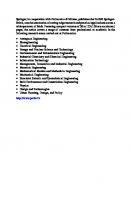
![Special Topics in Information Technology [1 ed.]
9783030624767, 9783030624750](https://ebin.pub/img/200x200/special-topics-in-information-technology-1nbsped-9783030624767-9783030624750.jpg)
![Special Topics in Information Technology [1 ed.]
9783030859183, 9783030859176](https://ebin.pub/img/200x200/special-topics-in-information-technology-1nbsped-9783030859183-9783030859176.jpg)
